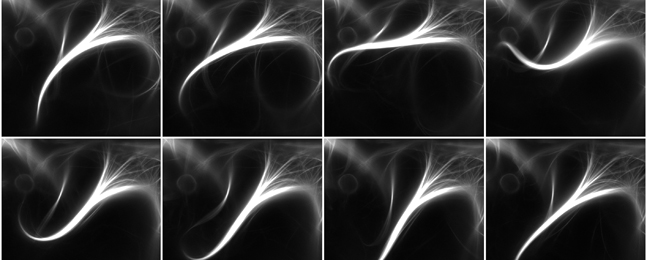And the Beat Goes On

Cilia are tiny, elegant structures with very big jobs, such as clearing microscopic debris from the lungs.
If you’ve ever been to a baseball game in Boston’s famed Fenway Park, you’ve probably done it: helped create the enormous synchronized wave that travels around the entire stadium. It’s not easy to pull off, and initial efforts often falter — but, when it works, “the wave” is a marvelous gesture of fandom.
Well, spectator waves aren’t the only patterned movements worth marveling over. Cilia and flagella (the names are interchangeable), diminutive hairlike structures found on cells, also use synchronized beating motions to perform outsized feats, such as clearing microscopic debris from the lungs and determining the correct location of organs during development.
Captured on video through a microscope, cilia appear as long, skinny arms or little whips on the cell perimeter, all doing the breast stroke in mesmerizing synchrony. How do they do that?
So far, just how they manage their coordinated beating motions has eluded full scientific understanding. Now a team of Brandeis researchers has developed artificial cilialike structures, offering a dramatic new approach to studying these tiny movers and shakers and potentially cracking open the secret of their mysterious choreography. In a paper published in the journal Science, Zvonimir Dogic, associate professor of physics, and Daniela Nicastro, assistant professor of biology, and their colleagues reported the first example of a simple microscopic system that selforganizes to produce cilialike beating patterns.
The group turned on its head the conventional top-down approach of deconstructing a cilium by systematically eliminating its many components. Dogic and Nicastro, with the help of graduate students Timothy Sanchez and David Welch, created an experimental system with only three main components: microtubule filaments — tiny hollow cylinders found in both animal and plant cells; motor proteins called kinesins, which consume chemical fuel to move microtubules along; and an agent that induces assembly of filaments into bundles.
The team discovered that under certain conditions these simple components spontaneously organize into active groups that beat in a periodic manner. Moreover, the researchers were able to assemble a dense field of bundles that spontaneously synchronized their beating patterns into traveling waves.
This bottom-up success is a first step that has implications for human health as well as other areas, such as nanotechnology. “While biologists explore the behavior of cilia as it currently exists, our work explores the behavior of cilia that could exist,” says Dogic.
— Susan Chaityn Lebovits
